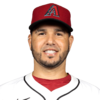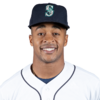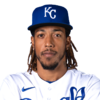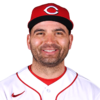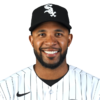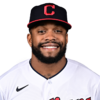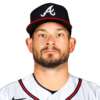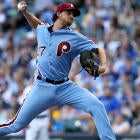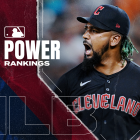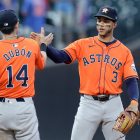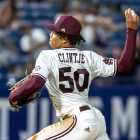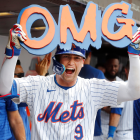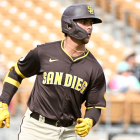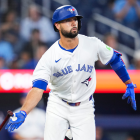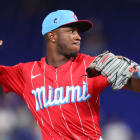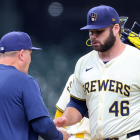If you ever want to feel humbled, try playing fantasy baseball every year in a high-level league against top-shelf competition. You'll pop up from the draft table after hours of agonizing, thinking you've just drafted a perfect team ... only to realize, for the millionth time, how unpredictable the game can be, and how spectacularly wrong you are.
With 161 games in the books and a battle for the ages going down to the final day of the season in the maniacal, three-sport bonanza that is the League of Leagues, let's check in on my five biggest hits and five biggest misses this season, and the lessons we can glean from each.
FANTASY HITS
Drafted seven rounds after Jake Lamb, Suarez proved to be a colossal bargain compared to other third basemen. His 34 home runs and 104 runs batted in both rank third among all hot-cornermen.
The lesson: Suarez checked a bunch of boxes as a sleeper pick with upside this year. He turned 27 in 2018, often a prime age for breakouts. He also showed improving skills heading into this season, with career highs in multiple categories last year, including a much-improved batting eye. Moreover, Suarez reminded us that players on lousy teams can fly under the radar. I've already got my eyes on half the Padres lineup for next year.
The player drafted right before Smith in the 42nd round of League of Leagues was Derek Fisher, and it wouldn't make a lick of difference if it was the busted Astros prospect or the former guard who played his last NBA game four years ago -- they provided exactly the same amount of value in 2018. Smith's 38 stolen bases ranked third in the majors this year, his baserunning derring-do fueled by subtle improvements in his plate discipline.
The lesson: Look for players with impressive minor league track records, even if their major-league numbers haven't yet caught up. He posted consistent double-digit walk rates throughout his minor league career, swiping a wildly impressive 64 bases in 110 five years ago at Single-A ball. You take a chance on a player like that, even when everyday playing time isn't assured at first.
The Phillies tabbed Nola with the seventh pick in the 2014 draft, hoping to develop an ace. An elbow injury torpedoed him two years later, followed by a back injury that felled him for a month in 2017. The stuff was always there, with Nola wielding a live fastball and a vicious curve. He finally got over the injury hump this year, and came through with monster numbers as a result: a 17-6 record, 224 strikeouts, a 2.37 ERA, and most telling of all, 212 ⅓ innings pitched, the third-highest total in the National League.
The lesson: Bet on skills and pedigree, even when the results haven't yet arrived. In Nola's case, it was simply matter of staying healthy for a full season, which he finally did.
Players who went in the same round as Clevinger in League of Leagues: Lewis Brinson, Neil Walker, and Mike Zunino. The Brinson, Walker, and Zunino fans failed to consider Clevinger's 27.3 percent strikeout rate in 2017, a number that offered promising potential for future excellence, if the long-haired right-hander could simply refine his command a bit. He did just that this season, combining increased experience, hard work, and lessons learned from his eccentric rotation mate Trevor Bauer. As a result, Clevinger delivered career-best marks in innings pitched (200) and ERA (3.02), while chopping off nearly one and a half walks per nine innings from his 2017 total.
The lesson: If you know that three other teams in the same division will be in full rebuild mode, try to capitalize as aggressively as possible. Bauer and Jose Ramirez had huge breakout seasons this year partly due to the pushover nature of the AL Central, and so did Clevinger.
One of the best waiver-wire pickups in this or any other rotisserie league this year, Mondesi has burst into flames over the past three weeks, swatting nine homers and stealing 11 bases in that span. A second-half terror, Mondesi's prorated numbers over 162 games are obscene: 31 home runs, 81 RBI, 103 runs scored, 66 steals. Whatever Mondesi's projected cost is next year, bid a little higher to get him.
The lesson: Keep close tabs on all 30 teams, throughout the entire season. When a post-hype prospect like Mondesi starts to swipe a bag or two and show signs that he might get an extended run of playing time, you have to ready to pounce. By the time the young shortstop was seemingly stealing a base or hitting a homer almost every game (and often in the same game) it was far too late to pluck him off the wire.
FANTASY MISSES
The future Hall of Famer and erstwhile hitting machine was still an on-base god this year, with his fourth straight season topping a .400 OBP producing tons of value for OBP-based leagues like ours. His power disappeared, though, with Votto on pace to hit fewer homers than in any full season of his long career ... by a mile. On the surface, this looks like just a case of bad luck, with Votto cracking home runs on just 9.8 percent of the flyballs he hit in 2018, by far the lowest mark of his career and something you might normally call a fluke. But three weeks after his 35th birthday, it's fair to wonder if that steep dropoff in fence-clearing stems simply from a reduction in bat speed and reaction time that eventually catches up to every player with age.
The lesson: After taking Karl-Anthony Towns with the seventh overall pick in our three-sport league, I knew I wanted a star baseball player in Round 2. The choice came down to Votto or Nationals speedster Trea Turner. I chose Votto, partly because I loved the OBP upside but mostly because Turner's injury history scared me. Votto's age should have scared me more. When in doubt, choose the younger guy.
In his first two major-league seasons following his abbreviated 2013 debut, Myers played in just 87 games with the Rays in 2014 and just 60 games with the Padres in 2015. He then followed those injury-marred campaigns with two remarkably healthy seasons, averaging 156 games played, 29 homers and 24 steals in 2016-2017. Pure fool's gold. Myers got hurt again this year, and while his per-162 games rates in homers and steals aren't far off peak levels, your early-round pick is going to go bust when your guy plays just half a season.
The lesson: While Nola's injury history provided an opportunity to buy low on a future ace, Myers produced a much more aggressive average draft position, because his injury woes happened a little further in the past. There's no guarantee that a player who's suffered a bunch of injuries will keep hitting the DL going forward (unless that player is Nick Johnson, anyway). But the price has to be right to take that risk.
Andrus in 2017: .297/.337/.471, 20 homers, 88 RBI, 100 runs, 25 steals
Andrus in 2018: .258/.311/.370, 6 homers, 33 RBI, 53 runs, 6 steals
The lesson: Don't overreach after a big breakout season, because regression can be a powerful force working against you. Sure, few could have predicted that Andrus's speed would crash even harder than his power did. But expecting a repeat of 2017 was asking too much.
With great speed, lofty walk rates, and minimal power throughout his pro career, you could have argued for Deshields as a breakout candidate in the same vein as Mallex Smith. The difference was that Smith made a lot more contact than Deshields did at every level, making Deshields a much bigger batting average risk, and thus more of a risk to fall short of expectations. A .213/.308/.279 line certainly qualifies, even though Deshields still scraped together 20 steals.
The lesson: Speed demons who can't hit run the risk of losing their jobs, and thus failing to deliver on their stolen-base upside. Deshields was basically a lesser, American League version of Billy Hamilton in 2018.
Hand looked like the last closer left on our draft board who offered elite peripheral skills, including the kind of flashy strikeout rate you want to see in your saves guys. Picking him well after the likes of Luis Castillo, Andrus, and Myers looked like a great call when Hand rang up 24 saves and 65 strikeouts in 44 ⅓ innings as a Padre. When San Diego dealt him to Cleveland on July 19, though, it looked like Hand's time as a valuable reliever had run out, since Cody Allen now stood ahead of him in the saves pecking order. I foolishly dropped Hand, only to watch him not only maintain his impressive K rate but also rack up eight more saves.
The lesson: Bullpen setups are more fluid now than they've been in decades, with teams increasingly divvying up their save totals among multiple relievers, using their nominal closers in high-leverage situations that might not correspond to save situations. Allen and Hand proved somewhat interchangeable as options in the ninth inning or earlier, leading to a closer timeshare situation that made Hand a foolish drop. The next time your ace closer gets dealt to a contender with a ninth-inning guy already in place, take a little time to figure out what's coming next before hitting the eject button.



